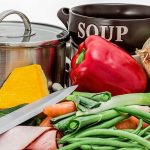
Our experiences about food may well have changed dramatically with the pandemic. So when it comes to following food trends in the COVID era we can expect to see sudden shifts in all the predictions from those at the beginning of 2020.
Most of us in the world have experienced seismic alterations to our lifestyle. Some of us may have had the virus and not suffered at all whilst some of us may have seen life-changing alterations. We’ve also had to cope with new ways of living and socialising as we entered periods of lockdowns followed by release as it were and then a further lockdown on top of that. We’ve also had to deal with how we plan our diet if we catch COVID and what that recovery diet needs to be, and that has not been straightforward for many.
From a food manufacturing and food development perspective, dealing with the pandemic has also meant considerable upheaval. New ways of thinking about food have been explored to accommodate our new ways of living. Not until we have a vaccine will we feel certain of relaxing on social distancing or hanging up our facemasks on a peg rather than on our nose.
What Does Market Research Tell Us About Food Trends In the COVID Era?
Most market research firms have noticed that in most developed countries there was a substantial shift by consumers from eating out to eating in. In response, the food industry has shifted too from its heavily focused retail food service to more at-home preparation.
Indeed some researchers reckoned that there were two distinct camps of consumer. In the first camp were those who saw it as the opportunity for healthy cleansing of their body and their lifestyle. They were keen to find all the information they could on healthy foods and recipes that would meet their requirements.
In the second camp there was a marked interest in using all that extra time in furlough and time-off to indulge themselves in a similarly hedonistic manner. One of the issues being to combat boredom.
With what is seen as a more unhealthy lifestyle came unhealthy eating. Part of this was fueled by storing more food at home with the extremes being some form of hoarding and stockpiling. In this particular camp too, consumers were into extra snacking and eating generally was prevalent.
What Happened To Snacks And Snacking?
Snacks and snacking became a key feature for many of us because being cooped up at home meant a substantial increase in the opportunity to eat these types of food. The consequences were either health or unhealthy snacking. In a large number of situations people were really looking for comfort food.
Similar snacking phenomenon occurred not that long ago.
The 2008 economic crisis saw a familiar rise in all the indulgent categories and not just snacks but confectionary too. These two categories never seem to ever suffer during times of economic recession and the same will probably be said of the recent pandemic. It’s all about people looking to afford a treat to keep them bolstered during the tough times ahead. Indulgence is the key opportunity for the food developers here.
The Consumer – What Those Market Research Reports Say
So being effectively in quarantine with lockdown meant snacking habits produced wide swings in consumption. According to Ipsos, our behaviour was oscillating between eating comfort food and enhanced diligence to healthier habits.
Apparently 90% of consumers recently surveyed in that Ipsos poll also claimed that eating their favourite snack made them ‘feel normal’. This type of trend will no doubt continue as we face periods of lockdowns.
Although comfort foods are not always healthy, 66% of people stated they did not feel any guilt after indulging in the favourite comfort food. In there case it was clear that a high calorie counts was not going to stop them with comfort eating during the COVID-19 outbreak. Consumers also bought more snacks and comfort food during the lockdown (79%).
Not a surprise; chocolate was most popular (90% of us thought so) according to a Flavorchem survey.
There was another aspect to comfort which came through – a return to childhood indulgence rather than childish eating. Nostalgic flavours such as cinnamon and S’mores were mentioned more than once by respondents on a variety of polls. These traditional flavours have gained greater traction as consumers recreate experiences they are not currently able to follow.
Becoming The Chef At Home
It probably is not much of a surprise that having extra time at home meant that many of us turned to home cooking. Part of the reason is that restaurants and clubs have closed throughout much of the lockdown which has disrupted socialising.
We’ve also been indulging in take outs as well but I’m sure we will come onto that later.
Being at home has allowed us to develop cooking as more of a hobby and to even make it the lynch pin of new businesses. There was a survey from Google stating a 26% rise in new web-sites devoted to cuisine and recipes. That’s quite a jump because there are already plenty of sites out dealing with the subject.
Baking Goes Potty!
Well this is one classic example of what happens with an enforced stay at home. Baking as a pastime rises because it’s a way to pass the time and produce our own sweet treats.
Nielsen reported sales of baking mixes rose by 153% and baking staples such as yeast, baking chips, baking soda, frostings, decorations, dried fruit and so on were up by 126% which meant an awful lot of muffins and cupcakes.
One of the biggest consumer trends was making our own bread.
In fact purchasing a bread making machine was a necessity and must and sales of these by whatever outlet rose steadily by 800% according to the NPD group.
There were some interesting national statistics about baking.
During the lockdown, 36% of the French made their own cakes and desserts rather than purchase from the classic patisserie. There is even some evidence that watching cooking programmes rose almost immeasurably as people tried to recreate the skills of the master bakers.
In the UK, the Great British Bake Off is immensely popular and extended its worldwide audience as many others watched with drooling interest not only the trials and tribulations but how to make some of their own baked goods.
The evidence from Nielsen was that sales of baking products rose by two-thirds over the same period of 2020 when compared to the previous year. Nielsen also noticed that of shop bought items, blueberry muffins, filled doughnuts , cookies and coffee cake and some with walnuts were all top 10 growth items between January and March of 2020 before the pandemic crisis hit. It may have been a case of some short-term stockpiling for treats before the lockdown ensued.



Leave a Reply